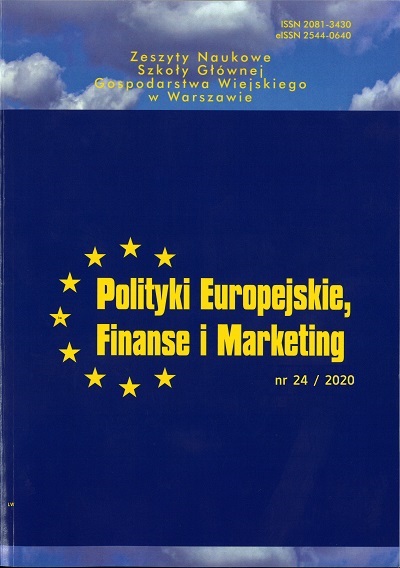Main Article Content
Article Details
Davydenko N.: The impact of the shadow economy on the financial potential of the regions. Problems and prospects of financial system development in modern conditions: collection of materials of the II International scientific-practical Internet conference, Poltava, PUET, 2020.
Feige E.: The Underground economies. Tax evasion and information distortion, Cambridge University Press, 2007.
Feige E.: How Big is the Irregular Economy? Challenge, 1979. (Crossref)
Gutmann P.: The Subterranean Economy. Financial Analysts Journal, Vol. 33, 1977. (Crossref)
Kosmarova N.: Shadow economy in EU countries. Current issues of international relations (part II), 2013.
Loayza, N. The economics of the informal sector: a simple model and some empirical evidence from Latin America. The World Bank, 1999. (Crossref)
Mazur I.: De-shadowing of the economy of Ukraine: theory and practice, VPTs "Kyiv University", 2006.
Medina L. and Schneider F.: Shadow Economy Around the World: What did we learn over the last 20 years, International Monetary Fund, 2018. (Crossref)
Mocherny S.: Economic Encyclopedia Vol. 3, Academy, Kyiv, 2002.
Ponomorenko T., Olvinska J.: Comparative analysis of the shadow economy of the world. Statistics - an instrument of socio-economic research: a collection of scientific student works, Issue 2, Odessa, ONEU, 2016.
Schneider F.: Dimensions of the Shadow economy, The Independent Review, V. 5, #1, Oakland, CA, 2000.
Schneider F., Klinglmair R.: Shadow Economies on the Rise Around the World. What do we know? Discussion Paper No. 1043, Bonn, 2004. (Crossref)
Schneider F.: Size and Development of the Shadow Economy of 31 European and 5 other OECD Countries from 2003 to 2012 Some New Facts. https://www.researchgate.net/publication/268185661_Size_and_Development_of_the_Shadow_Economy_of_31_European_and_5_other_OECD_Countries_from_2003_to_2012_Some_New_Facts
Schneider F. The Shadow Economy in Europe, Austria, 2013. http://feelingeurope.eu/Pages/Shadow_Economy_in_Europe.pdf (Crossref)
Schneider F.: Shadow Economy in Turkey and in other OECD-Countries: What do we (not) know? Retrieved February 15, 2013 from http://www.gep.gov.tr/tmp/BSECpdf/Prof. Dr.FriedrichSchneiderShadEc_Turkey2012.pdf (Crossref)
Schneider F.: Size and Development of the Shadow Economy of 31 European and 5 other OECD Countries from 2003 to 2015: Different Developments. Journal of Self – Governance and Management Economics, 3(4), 2015.
Soto E.: The other way. The invisible revolution in the third world, transl. from Engl. B. Pinsker. Moscow: Catallaxy, 1995. https://www.e-reading.club/bookreader.php/53846/De_Soto_-_Inoy_put.htm
Tanzi, V.: Uses and Abuses of Estimates of the Underground Economy. The Economic Journal, 109 (June), 1999. (Crossref)
The shadow economy in Ukraine. The results of the 2019 study. Kyiv International Institute of Sociology. https://www.kiis.com.ua/?lang=eng&cat=reports&id=897&page=1
Thomas J.: Quantifying the black economy: «measurement without theory» yet again? The Economic Journal, 109 (June), 1999. (Crossref)
Turchinov O.: Shadow economy: theoretical bases of research. Kyiv «ArtekEk», 1995.
Vasenko V.: Shadow economy of Ukraine and ways of its de-shadowing. Visnyk of Cherkasy National University. Economic Sciences Series, #1, 2016.
Wasilewska N., Kaminska T.: Preconditions of land relations development: economic, legal and institutional. Zeszyty Naukowe SGGW, Polityki Europejskie, Finanse i Marketing [t.20(69)], 2018.Weiner E.: Hidden power. How rich states and influential investors control the whole world, Мoskwa Alpina Business Book, 2012. (Crossref)
Zaverukha M.: To determine the essence of shadow economic processes. Efficiency of public administration, Lviv, LRIDU NADU,2016.
Downloads
- Anna Milewska, Podmioty wykonujące samorządowe zadania publiczne – specyfika działania i finansowania , Zeszyty Naukowe SGGW, Polityki Europejskie, Finanse i Marketing: Nr 23(72) (2020)
Możesz również Rozpocznij zaawansowane wyszukiwanie podobieństw dla tego artykułu.
- Mirosław Wasilewski, Joanna Żurakowska, Faza cyklu życia przedsiębiorstwa a struktura kapitału przedsiębiorstw przemysłowych , Zeszyty Naukowe SGGW, Polityki Europejskie, Finanse i Marketing: Nr 23(72) (2020)
- Marzena Ganc, Mirosław Wasilewski, Metodyka rozliczania i kalkulacji kosztów w spółdzielni mleczarskiej , Zeszyty Naukowe SGGW, Polityki Europejskie, Finanse i Marketing: Nr 25 (74) (2021)
- Natalia Wasilewska, Tatiana Bludova, Oleksiy Kudenko, Volodymyr Tokar, EVALUATION OF TARGET MARKET SEGMENTS FOR ENTERPRISES , Zeszyty Naukowe SGGW, Polityki Europejskie, Finanse i Marketing: Nr 22(71) (2019)
- Nadiia Davydenko, Alina Buriak, Natalia Wasilewska, Mirosław Wasilewski, Zarządzanie ryzykiem rozwijania potencjału finansowego podmiotów gospodarczych , Zeszyty Naukowe SGGW, Polityki Europejskie, Finanse i Marketing: Nr 29(78) (2023)
- Nadia Davidenko, Natalia Wasilewska, Zapewnienie równowagi finansowej przedsiębiorstw rolnych na Ukrainie , Zeszyty Naukowe SGGW, Polityki Europejskie, Finanse i Marketing: Nr 26(75) (2021)
- Natalia Wasilewska, Nadiia Davydenko, FINANCIAL MANAGEMENT MODELING FOR ENTERPRISES , Zeszyty Naukowe SGGW, Polityki Europejskie, Finanse i Marketing: Nr 19(68) (2018)
- Natalia Wasilewska, Nadiia Davydenko, Assessment of the Credit Historyod Enterprises , Zeszyty Naukowe SGGW, Polityki Europejskie, Finanse i Marketing: Nr 18(67) (2017)
- Natalia Wasilewska, Tetiana Kaminska, PRECONDITIONS OF LAND RELATIONS DEVELOPMENT: ECONOMIC, LEGAL AND INSTITUTIONAL , Zeszyty Naukowe SGGW, Polityki Europejskie, Finanse i Marketing: Nr 20(69) (2018)
- Mirosław Wasilewski, Anna Bischoff, Współpraca w zakresie wymiany informacji podatkowej między Polską a krajami UE , Zeszyty Naukowe SGGW, Polityki Europejskie, Finanse i Marketing: Nr 19(68) (2018)

Utwór dostępny jest na licencji Creative Commons Uznanie autorstwa – Użycie niekomercyjne 4.0 Międzynarodowe.





